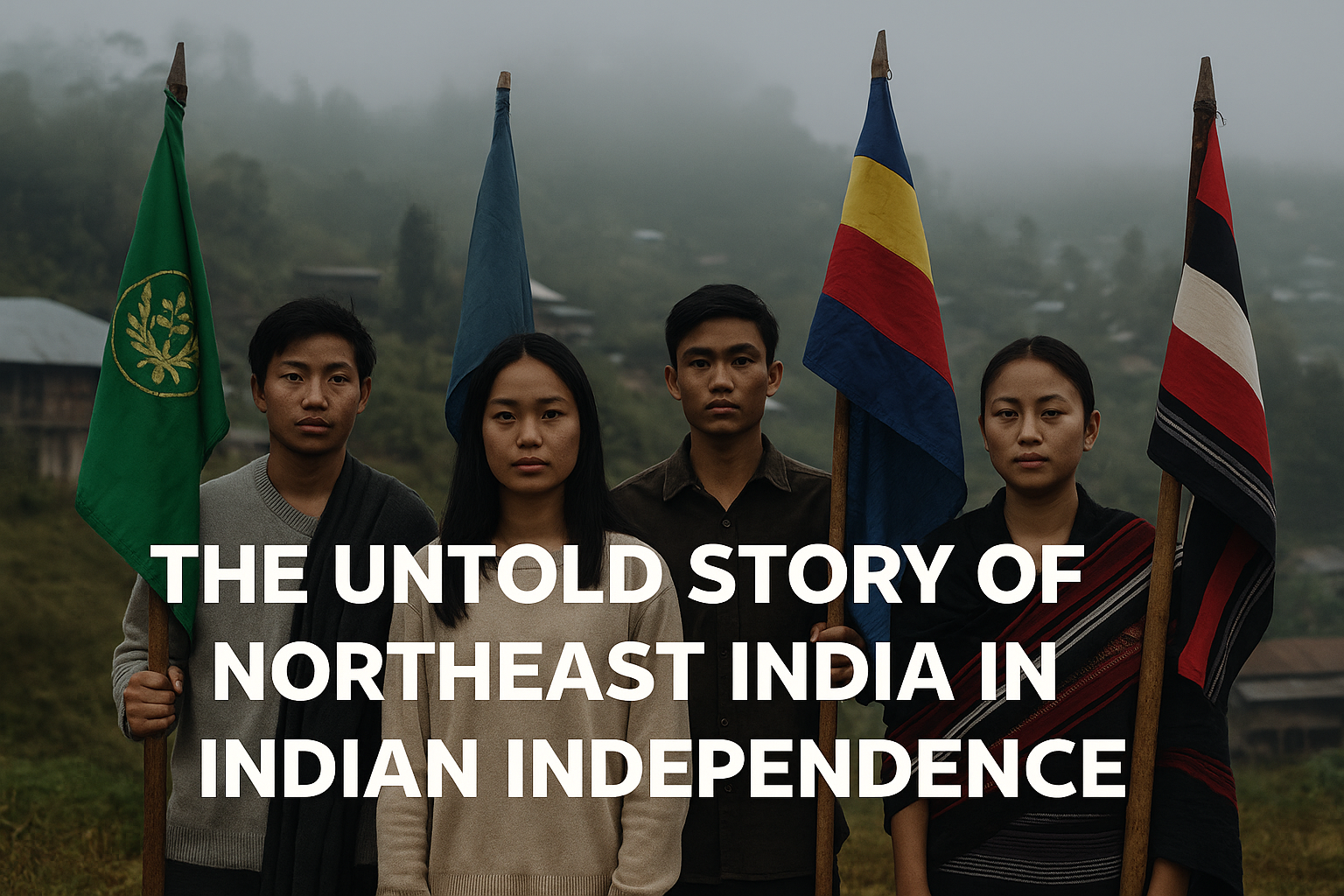When we think of India’s freedom struggle, certain names echo loud: Gandhi. Nehru. Bhagat Singh. Subhas Chandra Bose.
Certain cities come to mind: Delhi, Bombay, Lahore, Calcutta. What about the North East India freedom struggle?
But what about Kohima?
What about Imphal, Aizawl, or Itanagar?
The Northeast of India, with its lush hills, fierce spirit, and quiet strength, played a crucial — yet often overlooked — role in India’s road to independence. Its story is not absent from history… It’s simply been under-told.
This blog is an invitation — not just to remember, but to reclaim.
To give voice to a land and its people who stood not only for survival, but for sovereignty.
A Region Rich in Identity and Resistance in the North East India Freedom Struggle
North East India is not one place. It’s eight states, over 200 tribes, and hundreds of dialects — each with its own culture, traditions, and truths.
Yet despite this diversity, one thread runs strong: resilience.
Before British rule, many of these communities were sovereign. They had their own systems, their own rhythms. Colonialism didn’t just bring railways and red tape — it disrupted entire ecosystems of life and leadership.
What followed was not passive acceptance — it was active resistance.
The Quiet Flames of Rebellion
The Anglo-Kuki Rebellion (1917–1919)
While World War I raged, the British tried to conscript Kuki men from Manipur. The Kukis refused. What followed was a three-year guerrilla war across the hills — a rebellion not of armies, but of ordinary people defending dignity.
The uprising was eventually crushed, but the spirit never broke.
Rani Gaidinliu — The Teenage Freedom Fighter
Born in 1915 in a small Naga village, Gaidinliu was only 13 when she joined a spiritual and political movement led by her cousin Haipou Jadonang. After his execution by the British, she took over — leading a revolt at age 16.
She was arrested in 1932 and spent 14 years in jail.
Jawaharlal Nehru would later call her the “daughter of the hills” and urge the nation to remember her name.
Yet how many textbooks today do?
The Naga Resistance — A Fight for Identity
While some regions resisted British intrusion, others, like the Nagas, engaged with the British but later asserted autonomy. Post-independence, their struggle evolved — not against colonial rulers, but to safeguard identity and sovereignty.
This complexity is often painted in black and white. But the truth?
The North East was never just fighting for “India.”
It was fighting for its place within India, on its terms.
World War II: The Northeast as Battlefield
Few realise that some of the most brutal battles of World War II were fought not in Europe, but in Nagaland and Manipur.
The Battle of Kohima (1944) was pivotal. Japanese forces, aligned with the Indian National Army (INA), sought to enter India through the Northeast. What followed was 64 days of fierce fighting in the hills, known today as “The Stalingrad of the East.”
It wasn’t just soldiers who suffered. Entire villages were displaced.
Civilians bore the cost of war in silence.
To this day, the Kohima War Cemetery stands not just as a British memorial, but a testament to the strategic and emotional importance of this region in the broader independence saga.
Why This Story Was Forgotten
So why hasn’t this chapter been given its rightful place?
- Geographic isolation: The Northeast was physically distant from Delhi’s political core, and this shaped perceptions.
- Cultural differences: Tribal customs didn’t fit the nationalist template promoted by the Congress leadership.
- Narrative control: Post-independence, much of India’s history was written by and for its heartland, often overlooking its peripheries.
But erasure doesn’t mean absence. The spirit lived on — in oral histories, in songs, in the memories of grandmothers who still whisper, “We were there.”
The Deeper Cost of Silence
When we leave out the Northeast from our freedom narrative, we do more than forget facts.
We fragment the soul of a diverse nation.
How can we talk about unity in diversity, when we forget the sacrifices of those who never made the front page?
The result? A generation of youth from the region who grow up feeling invisible in the very country their ancestors bled for.
The Second Chance to Rewrite This Story
At The Second Chance in Life, we believe healing begins with recognition.
To the people of North East India, your contribution to India’s freedom was not small. It was monumental. And it deserves to be told, celebrated, and woven into the national consciousness.
To the rest of us, this is our chance to listen, learn, and lift a narrative that’s long been buried under mainstream history.
Why This Matters Today
Because identity is power.
>Because young people in the Northeast deserve to see themselves in their history books.
>Because honouring every voice is the only way to build a truly inclusive India.
And because remembering is a form of resistance.
A form of restoration.
A second chance — not just for the Northeast, but for all of us.
How You Can Start
- Read beyond your syllabus. Discover works by Northeast writers like Mamang Dai, Easterine Kire, and Temsula Ao.
- Support indigenous storytellers. Let the region speak for itself.
- Acknowledge complexity. Every part of India’s freedom story is nuanced. Embrace it.
- Start conversations. Share this story with one person today. That’s where change begins.
By Dr Bhaskar Bora
Explore the site to read more Blogs
For suggested further readings, Click Here
#TheSecondChanceInLife #NortheastIndia #IndianFreedomStruggle #UnsungHeroes #TribalVoices #KohimaBattle #RaniGaidinliu #IndigenousResistance #ForgottenHistory #InclusiveIndia



